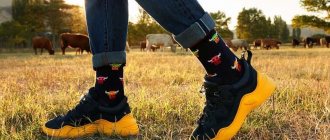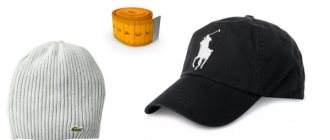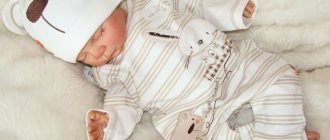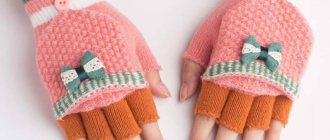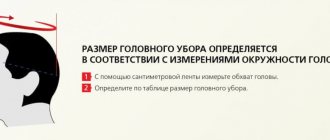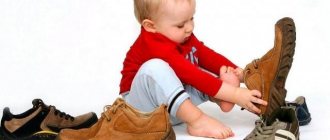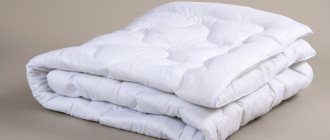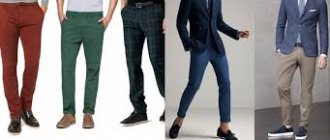How to determine the size of children's socks
In order to understand what size socks your child needs, you need to measure his foot. There is a fairly simple and effective method that will be useful to you.
- Take a sheet of white paper, notebook or landscape (the main thing is that it is larger than the baby’s foot)
- The child must stand on the sheet
- Draw an outline around his foot
- On paper, mark the center point of the heel contour
- The second point is placed on the outline of the thumb
- Measure the distance between the points (with a ruler, metric tape or tape measure)
The resulting length of the segment, in centimeters, will then determine the size of the foot.
Children's hat sizes
| Age | Hat size |
| 0-3 months | 35 |
| 3 months | 40 |
| 6 months | 44 |
| 9 months | 46 |
| 12 months | 47 |
| 1.5 years | 48 |
| 2 years | 49 |
| 3 years | 50 |
| 4 years | 51 |
| 5 years | 52 |
| 6 years | 53 |
| 7 years | 54 |
| 8 years | 55 |
| 9 years | 56 |
| 10 years | 56 |
| 11 years | 57 |
| 12 years | 58 |
Size designations for children's socks
Manufacturers of socks, even within the same country, may have different sizes of socks for children; it is worth remembering the most typical tables that are found. For example, some hosiery manufacturing companies in Russia mark children's socks with even numbers, omitting odd ones, while others use whole numbers sequentially. At the same time, the products have foreign (10.5) or letter (S, M, L) designations.
If the age is indicated on the socks, this indicates the elasticity of the material of the product and its ability to adapt to 3 adjacent sizes. When choosing socks labeled by age, it is worth considering that at maximum stretch the fabric will become thinner, which can create pressure on the toes and the instep if it is high. An average division of products by age group will be useful if knee socks are purchased as a gift for the children of friends whose parameters are not possible to find out.
| Age | Foot length in cm | Russian size |
| 0-1 month | up to 6.4 | 10 |
| 0-1.5 months | 6,5-7,4 | 10 |
| 0-3 months | 7,5-8,4 | 10 |
| 1.5-3 months. | 8,5-9,4 | 10 |
| 3-6 months | 9,5-10,4 | 10 |
| 6-9 months | 10,5-11,4 | 12 |
| 9-12 months | 11,5-12,4 | 12 |
| 1-1.5 years | 12,5-13,4 | 14 |
| 1.5-2 years | 13,5-14,4 | 14 |
| 2-3 years | 14,5-15,4 | 16 |
| 3-4 years | 15,5-16,5 | 16 |
| 4-5 years | 16,5-17,4 | 18 |
| 5-6 years | 17,5-18,4 | 18 |
| 6-7 years | 18,5-19,4 | 20 |
| 7-8 years | 19,5-20,4 | 20 |
| 8-9 years | 20,5-21,4 | 22 |
| 9-10 years | 21,5-22,4 | 22 |
Sock sizes in Russia are designated by numbers from 6 (sometimes sock sizes for newborns are designated 0+) to 22, American products are labeled 2-12, and European ones are labeled 16-29. Asian sock sizes are often designated by letters and are always “small” compared to European ones. In order not to get confused by regional differences in product designations, it is useful to have comparative tables on hand, in which the sizes of children's socks from different manufacturing countries are indicated in parallel in one line.
| Age | Foot length, cm | European size | US size |
| 0-3 ms. | 9.5 | 16-17 | 0-2 |
| 0-6 months | 10.5 | 17-18 | 2,5-3,5 |
| 6-12 months | 11.7 | 19 | 4-4,5 |
| 12-18 months | 12.5 | 20 | 5-5,5 |
| 18-24 months | 13.4 | 21-22 | 6-6,5 |
| 2 years | 14.3 | 23 | 7 |
| 2.5 years | 14.7 | 24 | 7,5-8 |
| 2.5-3 years | 15.2 | 25 | 8-8,5 |
| 3-3.5 years | 16 | 26 | 9-9,5 |
| 4 years | 17.3 | 27 | 10-10,5 |
| 4.5 years | 17.6 | 28 | 11-11,5 |
| 5 years | 18.4 | 29 | 12 |
How to choose socks depending on the age of the child?
There are times when it is not possible to find out the exact parameters of a child’s feet, for example, if socks are bought as a gift, or if the purchase is made spontaneously, and there was no opportunity to take measurements before it. In such cases, you can use average data on the correspondence between foot size and age.
Size of socks and booties for children under one year old
When choosing socks for infants, you should pay attention to the material from which they are made; preference should be given exclusively to natural fabrics. It is also important that the elastic is not too tight, as it will press and pinch the leg. Booties should be chosen 1-2 sizes larger than socks, since they will not be worn on bare legs and should not be too narrow.
| Age, months | Foot length, cm | Size |
| 0-1 | 6,4-8,4 | 8 |
| 0-3 | 7,5-9,4 | 10 |
| 3-6 | 9,5-10,4 | 10 |
| 6-9 | 10,5-11,4 | 12 |
| 9-12 | 11,5-12,4 | 12 |
Sock sizes for children from 3 to 11 years old
At this age, children enter a phase of active growth, and the rate of change is individual for each child. By the age of 11, both height and foot size may differ significantly from the average, therefore, the older the child, the more careful you need to be when choosing socks and shoes without exact measurements.
| Size | Foot length, cm | Age, years |
| 16 | 15.5 — 16 | 3 |
| 18 | 16 — 17 | 4 |
| 18 | 17 — 17.5 | 5 |
| 18 | 17.5 — 18.5 | 6 |
| 20 | 18.5 — 19 | 7 |
| 20 | 19 — 19.7 | 8 |
| 20 | 19.7 — 20.5 | 8 |
| 22 | 20.5- 21 | 9 |
| 22 | 21 — 22 | 10 |
| 23 | 22 — 22.5 | 11 |
IMPORTANT! When choosing socks based on average data, you should give preference to elastic and well-stretchable materials, this will guarantee that the new thing will not be too small. It is worth remembering that a sock that is too stretched will bring much less heat and put pressure on your toes.
Size chart for children's socks by foot size
The length of the foot is the value by which the size of children's socks is determined. Below is the corresponding table.
| Foot length(cm) | Sock size |
| 9,7 | 10 |
| 10,4 – 11,0 | 12 |
| 11,0 – 11,6 | 12 |
| 11,6 – 12,2 | 12 |
| 12,2 – 12,8 | 14 |
| 12,8 – 13,5 | 14 |
| 13,5 – 14,2 | 14 |
| 14,2 – 14,8 | 16 |
| 14,8 – 15,5 | 16 |
| 15,5 – 16,2 | 16 |
| 16,2 – 16,9 | 18 |
| 16,9 – 17,6 | 18 |
| 17,6 – 18,3 | 18 |
| 18,3 – 19,0 | 20 |
| 19,0 – 19,7 | 20 |
| 19,7 – 20,4 | 20 |
| 20,4 – 21,1 | 22 |
| 21,1 – 21,8 | 22 |
| 21,8 – 22,5 | 23 |
Children's clothing size chart
| Age | Height | Breast | Waist | Hips | Size |
| 0-1 month | 45-50 | 41-43 | 41-43 | 41-43 | 50 |
| 1-3 months | 51-56 | 43-45 | 43-45 | 43-45 | 56 |
| 3-6 months | 57-62 | 45-47 | 45-47 | 45-47 | 62 |
| 6-9 months | 63-68 | 47-49 | 46-48 | 47-49 | 68 |
| 9-12 months | 69-74 | 49-51 | 47-49 | 49-51 | 74 |
| 12 months | 75-80 | 51-53 | 48-50 | 51-53 | 80 |
| 1.5 years | 81-86 | 52-54 | 49-51 | 52-54 | 86 |
| 2 years | 87-92 | 53-55 | 50-52 | 53-56 | 92 |
| 3 years | 93-98 | 54-56 | 51-53 | 55-58 | 98 |
| 4 years | 99-104 | 55-57 | 52-54 | 57-60 | 104 |
| 5 years | 105-110 | 56-58 | 53-55 | 59-62 | 110 |
| 6 years | 111-116 | 57-59 | 54-56 | 61-64 | 116 |
| 7 years | 117-122 | 58-62 | 55-58 | 63-67 | 122 |
| 8 years | 123-128 | 61-65 | 57-59 | 66-70 | 128 |
| 9-10 years | 129-134 | 64-68 | 58-61 | 69-73 | 134 |
| 10-11 years | 135-140 | 67-71 | 60-62 | 72-76 | 140 |
| 11-12 years old | 141-146 | 70-74 | 61-64 | 75-80 | 146 |
Popular sock models for girls and boys
Children's socks today come in a wide range, and the size of some of them should be selected in accordance with the specific characteristics of the material.
With rubber sole
Socks with rubber soles are a kind of comfortable indoor slippers designed for babies taking their first steps. The upper and insole are made of textile, the bottom from heel to toe is a rubber layer with a pattern.
The undoubted advantage of this model is the precise fixation of the leg, as well as its lightness and anti-slip effect. In order for the model to perform all its functions, it is worth choosing the exact size, because in oversized socks the foot will move inside the sock and cause discomfort to the baby.
With brakes
Another type of socks with non-slip soles are models with a small rubber pattern on the foot. Ovals and dots effectively prevent slipping on smooth surfaces, while at the same time allowing you to wear the model under shoes as regular socks.
The rubber pattern in anti-slip socks does not interfere with the elasticity of the models, allowing customers to purchase models with a small margin.
With leather sole
Socks with leather soles are referred to by users and some manufacturers as slip socks. Indeed, there are similarities in them. The toe and heel are made of soft leather, and the foot has a pleasant non-slip suede. The top of the socks is made of textile.
When purchasing such a model, it is important to remember that a large size of socks will gather in uncomfortable leather folds on the foot, and a small size will not fit on the leg. Therefore, before choosing this practical and convenient model, you should try it on your baby or take accurate measurements, correlating them with the manufacturer’s table.
With silicone sole
Socks with silicone inserts on the foot are a variant of anti-slip socks. Due to the transparency and softness of the material, the inserts are practically not felt by the child.
For membrane shoes
Membrane shoes, which are popular today, require special equipment. So, it is important to think about warm and comfortable socks. First of all, you need to remember that cotton socks should not be worn under membrane shoes. This is explained by the property of cotton to absorb, but not remove moisture, which means that the baby’s feet, sweaty when going to the store, will be wet and cold throughout the way home.
Special socks for membrane shoes remain dry even when your feet sweat, drawing moisture out. A current and warm option are models made of merino wool with the addition of synthetic fibers, as well as fleece.
Basketball
Basketball socks will come in handy for beginning athletes, because this new look in the sock industry is gaining more and more fans. Its features can be considered soft, but well-fixed fabric, reinforcement in the toe and heel areas. Such models will last much longer than conventional models, because they are not in danger of abrasion and loss of presentable appearance.
For the pool
Children love water, but parents are in constant fear, because their beloved child can easily slip in the pool, and rubber flip-flops are not always convenient to take off and put on. Pool socks dispel all parents' worries.
The sole of the models is made of the finest textured rubber, and the upper is made of dense and very elastic textiles. The length of the socks reaches the ankle. The plasticity of the fabric makes the socks dimensionless, allowing you to wear them for more than one season. You can run around the pool and dive into the water in them without fear of losing them while swimming.
Seamless
Seamless socks for children eliminate the presence of seams on the toes. This model is especially relevant if there is a seam inside the shoe or the shoes are tight, and the seam on the toes inevitably begins to rub your fingers.
Seamless models are made from any materials. Cotton and synthetic socks without seams are a convenient product for the comfort of children's feet.
Heated
Children, just like adults, often have to wait for a long time for the bus and freeze in the subway on the way to school and back. Cold feet certainly lead to colds and unpleasant aching legs.
To avoid hypothermia of the feet, heated socks were invented, powered by a battery or batteries. The mechanism itself is located in the upper part of the sock and is absolutely invisible to others. Carbon plates evenly warm the surface of the foot up to 45-50 degrees and even when the shoes get wet they remain warm.
Sledki
Short socks associated with love perfectly insulate children's feet. In most cases, this option is suitable for babies under one year old, who are not yet aware of the dangers of a slippery floor, as well as for older children who control their movements. Factory models of footwear can also be made in textile versions, having rubber or silicone anti-slip inserts.
With toys
For babies under one year old, socks with toys are suitable. Knowing children’s love for looking at their own feet, manufacturers have created models with sewn-on toys, such as jingling stars, teddy bears and bunnies. Such models are not intended to be worn with shoes and perform purely decorative functions.
Sports
A child who plays sports will benefit from sports socks. They are more resistant to abrasion and stretching, and adhere well to the foot due to the increased proportion of elastic fibers. The percentage of natural threads in the composition is minimal, however, this does not prevent the socks from remaining comfortable and comfortable to wear.
Lungs
Socks in summer protect the baby’s feet from dirt and mechanical damage; their importance is great. Lightweight models are made from natural cotton, as well as cotton with synthetic threads. When choosing such models, it is important to feel the thinness of the product, as well as to experience pleasant tactile impressions, because on hot summer days, delicate skin is more susceptible to irritation.
Sock size chart for children by age
If you need to choose socks, for example as a gift, or for your child, but for growth, and you don’t know what size to take, then you can use the following table of average data on sock sizes based on the child’s age.
Sock sizes for babies from 3 to 36 months
| Age (months) | Sock size |
| 0-3 | 10 |
| 3-6 | 12 |
| 6-9 | 12 |
| 9-12 | 12 |
| 12-15 | 14 |
| 15-18 | 14 |
| 18-21 | 14 |
| 21-24 | 16 |
| 24-36 | 16 |
Sock sizes for children from 4 to 10 years old
| Age (years) | Sock size |
| 4-5 | 18 |
| 5-6 | 18 |
| 6-7 | 20 |
| 7-8 | 20 |
| 8-9 | 22 |
| 9-10 | 22 |
European sizes of children's socks by age and foot length (table)
If you have purchased or are planning to buy socks with EU on the label, this means that the sizes are European, the table for them is below.
| Child's age | Foot length(cm) | Sock size |
| 0-3 months | 9,5 | 16-17 |
| 0-6 months | 10,5 | 17-18 |
| 6-12 months | 9,5 | 16-17 |
| 12-18 months | 12,5 | 20 |
| 18-24 months | 13,4 | 21-22 |
| 2 years | 14,3 | 23 |
| 2.5 years | 14,7 | 24 |
| 2.5-3 years | 15,2 | 25 |
| 3-3.5 years | 16 | 26 |
| 4 years | 17,3 | 27 |
| 4.5 years | 17,6 | 28 |
| 5 years | 18,4 | 29 |
Sock size chart for children by age and foot length (USA)
If the label is marked US - socks from the USA, there are different size designations.
| Child's age | Foot length(cm) | Sock size |
| 0-3 months | 9,5 | 0-2 |
| 0-6 months | 10,5 | 2,5-3,5 |
| 6-12 months | 9,5 | 4-4,5 |
| 12-18 months | 12,5 | 5-5,5 |
| 18-24 months | 13,4 | 6-6,5 |
| 2 years | 14,3 | 7 |
| 2.5 years | 14,7 | 7,5-8 |
| 2.5-3 years | 15,2 | 8-8,5 |
| 3-3.5 years | 16 | 9-9,5 |
| 4 years | 17,3 | 10-10,5 |
| 4.5 years | 17,6 | 11-11,5 |
| 5 years | 18,4 | 12 |
Letter designations for sock sizes
If you come across a marking with Latin letters (S, M, L), then you can determine the size based on the decoding:
S – small (small)
M – medium
L – large (large)
Socks with the letter S - corresponds to Russian size 11 (from 3 to 6 months)
M – size 12 (6-12 months)
L – size 14 (from one to two years old)
Summary of the article:
Choosing the right size of socks for a child is a very important point, these tables will help you do it correctly. Do not forget to take into account that the data are averages; in reality, each child’s foot is individual.
Don’t forget about the material from which the socks are made, because they can stretch or shrink after washing.
Chinese manufacturers most often run small, their socks are smaller than the specified size, take this into account.
We wish you and your children good health!!!
Size charts
Classification is determined mainly by two criteria: foot size and age. To determine the size of socks for children, it is necessary to compare the measurement results with the manufacturer's grid values.
By foot length
There is no single classification of socks, since different manufacturers determine sizes in their own way. Therefore, it is important to focus on the size of the leg and check the measurements with the mesh of a specific brand.
Russian grid:
| Foot (cm) | Socks (No.) |
| 9,7–10,3 | 10 |
| 10,4–12,1 | 12 |
| 12,2–14,2 | 14 |
| 14,2–16,2 | 16 |
| 16,3–18,2 | 18 |
| 18,6–20,4 | 20 |
| 20,4–21,8 | 22 |
| 21,8–22,6 | 23 |
European classification of children's socks:
| Foot (in mm) | EU |
| 95–104 | 16–17 |
| 105–114 | 17–18 |
| 115–117 | 19 |
| 118-125 | 20 |
| 128–136 | 21–22 |
| 136–143 | 23 |
| 144–148 | 24 |
| 150–152 | 25 |
| 153–160 | 26 |
| 161–173 | 27 |
| 174–176 | 28 |
| 177–184 | 29 |
| 185-192 | 30 |
| 195-218 | 31-34 |
| 220-242 | 35-38 |
Classification of children's socks adopted in the UK and USA:
| Foot (in mm) | English rr | America rr |
| 1 | 2 | |
| 98–108 | 1,5 | 2,5–3 |
| 110–115 | 2–2,5 | 32,5 |
| 116–127 | 3–4 | 4–42,5 –5 |
| 128–134 | 4,5 –5 | 5,5–6 |
| 135–147 | 5,5–6 | 6,5–7,5 |
| 148–154–160 | 7–7,5 | 8–9 |
| 162–175 | 8–8,5 | 10–11 |
| 176–188 | 9–9,5 | 11,5–12,5 |
| 190–202 | 10–10,5 | 13–13,5–14 |
| 204–216 | 11–11,5 | 14–15,5 |
| 216–228 | 12 | 16–16,5 |
According to the age
If you choose children's socks for growing up, for future use or as a gift, then guessing the size can be very difficult. In this case, you will have to focus on the age of the child. Since children grow at different rates and differ in height and weight, you will have to focus on average parameters. Tables by age will help you determine the size of socks for children:
| Age (months) | Size |
| 0-1 | 6 |
| 1-1,5 | 7 |
| 1-3- | 8 |
| 1,5-3 | 9 |
| 3,5-6,5 | 10 |
European classification of socks for newborns and babies up to two years:
| Age (in months) | EU |
| 0–3 | 16–17 |
| 6 | 17–18 |
| 6–12 | 19 |
| 12–18 | 20 |
| 18–24 | 21–22 |
Children's sizes (2-12 years):
| Number of years | EU |
| 2 | 23 |
| 2–2,5 | 24 |
| 2,5–3 | 25 |
| 3–3,5 | 26 |
| 4 | 27 |
| 4–4,5 | 28 |
| 5 | 29 |
| 6–7 | 30 |
| 7–9 | 31-34 |
| 10–12 | 35-38 |
Correspondence
Manufacturers often use Latin letters rather than numbers to classify sizes. Decoding the symbols will help you determine the parameters:
| Marking | Foot size (in cm) | Age (in months) |
| SSS | 9–10 | 0–6 |
| SS | 10–11 | 6–9 |
| S | 11 | 9–12 |
| M | 12–13 | 12–24 |
| L | 13,6–14,8 | 24–48 |
Correspondence to Russian parameters of children's shoes and socks:
Author:
Anastasia Kukushkina
I hope you enjoy the article I have prepared for you! If you find errors in it, write to me about it! I will answer any questions you have, ask them!
